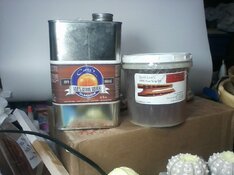I mentioned in the other thread on polymerized tung oil (PTO) that I use it on a majority of my turning projects except pens and a few other spindle projects. To date, I've only used PTO from Lee Valley, which is rather expensive at $51 per liter. Although expensive to buy, very little is used per bowl, a quart lasts me the better part of the year. However, money is money and I'm always looking for a deal.
A while back, someone at the AAW forum mentioned PTO from The Skin Boat Store, https://shop.skinboats.com/100-Pure-Tung-Oil-32oz-polymerized-t100.htm
The PTO they sell is $21 per quart and is un-diluted. Just got some today, so will post in this thread as I test it and see how it compares to the LV brand.
The oil from Skin Boat Store comes in a plastic wide mouth tub, so the first consideration is getting that transferred to some Stop Loss Bags so it won't all gel before it is used up. It comes un-diluted and will need a solvent added before you use it.

I decided to try some of their citrus solvent and see how that compares to MS that Lee Valley uses (50% dilution). I have several bowls that are either unfinished, or have a single coat of LV oil and all of them are black Locust, so have good material for side by side testing.
I mixed up 2 - 20ml test samples of oil, one with citrus solvent and the other with naptha (my mineral spirits is in the shed, and I didn't want to hike out there and get it at midnight). Both were diluted 50%. First impression - you better like the smell of orange oil because it is strong smelling!
My usual method is to apply with a cotton cloth, and let the bowl sit for a minute or two before wiping excess off gently with white paper towels. Exception to this is with a first coat, I'll keep adding more oil for several minutes if the wood is absorbing it.
Consistency of the oil after dilution was very similar to that of LV, and seemed to wipe on the same. The big difference was how quickly the bowls with naptha became tacky, much too soon for my liking. The citrus solvent mix reacted much the same as the LV oil.
The test now is to see if this tung oil dries as quickly and has the same build/sheen as that from LV. More to come on that tomorrow.
A while back, someone at the AAW forum mentioned PTO from The Skin Boat Store, https://shop.skinboats.com/100-Pure-Tung-Oil-32oz-polymerized-t100.htm
The PTO they sell is $21 per quart and is un-diluted. Just got some today, so will post in this thread as I test it and see how it compares to the LV brand.
The oil from Skin Boat Store comes in a plastic wide mouth tub, so the first consideration is getting that transferred to some Stop Loss Bags so it won't all gel before it is used up. It comes un-diluted and will need a solvent added before you use it.

I decided to try some of their citrus solvent and see how that compares to MS that Lee Valley uses (50% dilution). I have several bowls that are either unfinished, or have a single coat of LV oil and all of them are black Locust, so have good material for side by side testing.
I mixed up 2 - 20ml test samples of oil, one with citrus solvent and the other with naptha (my mineral spirits is in the shed, and I didn't want to hike out there and get it at midnight). Both were diluted 50%. First impression - you better like the smell of orange oil because it is strong smelling!
My usual method is to apply with a cotton cloth, and let the bowl sit for a minute or two before wiping excess off gently with white paper towels. Exception to this is with a first coat, I'll keep adding more oil for several minutes if the wood is absorbing it.
Consistency of the oil after dilution was very similar to that of LV, and seemed to wipe on the same. The big difference was how quickly the bowls with naptha became tacky, much too soon for my liking. The citrus solvent mix reacted much the same as the LV oil.
The test now is to see if this tung oil dries as quickly and has the same build/sheen as that from LV. More to come on that tomorrow.







